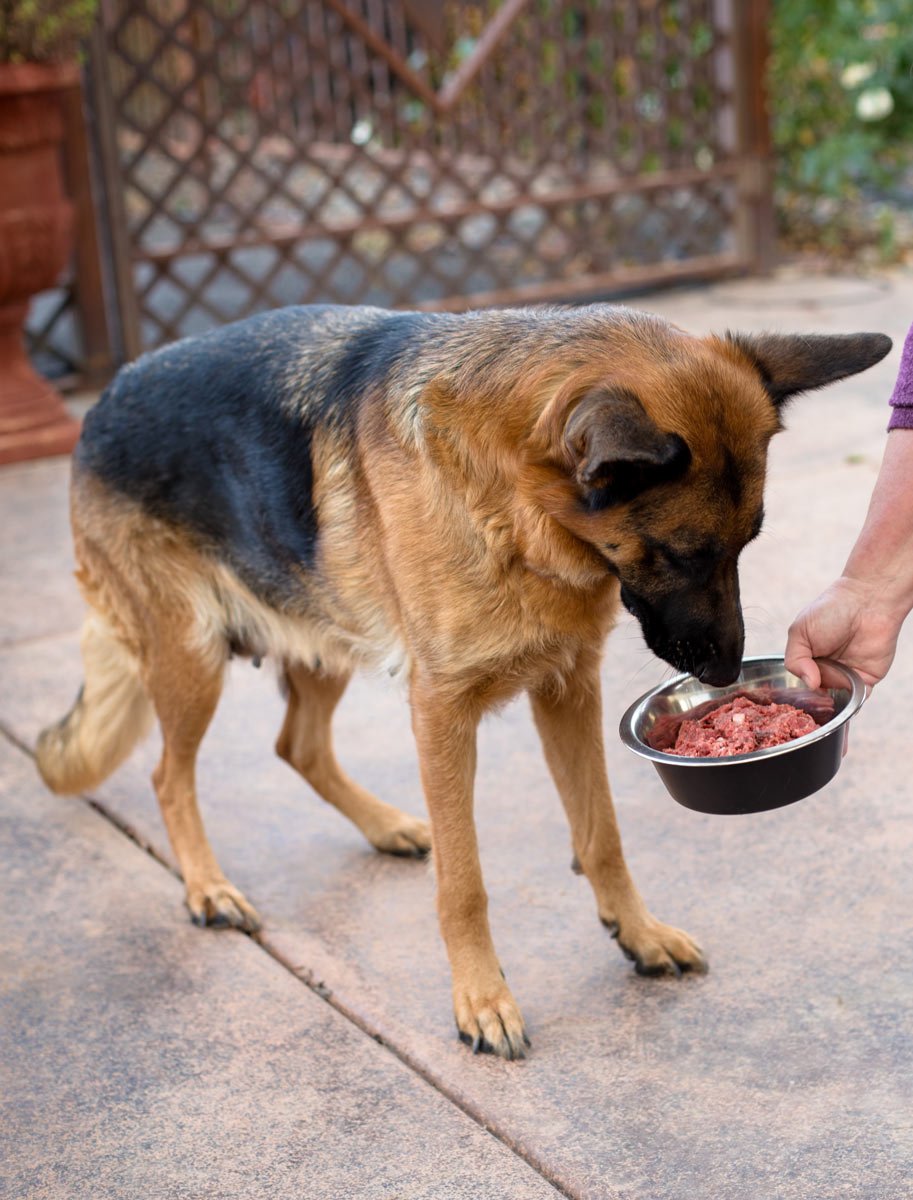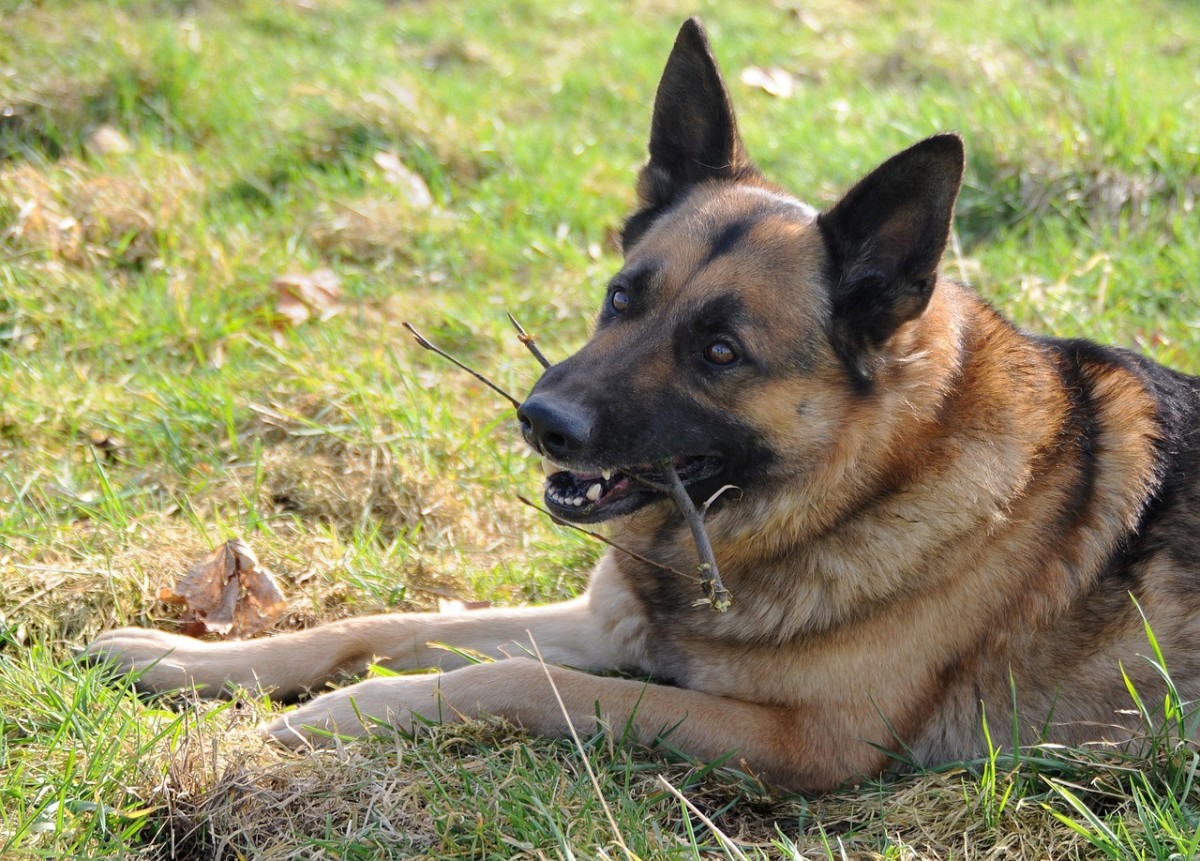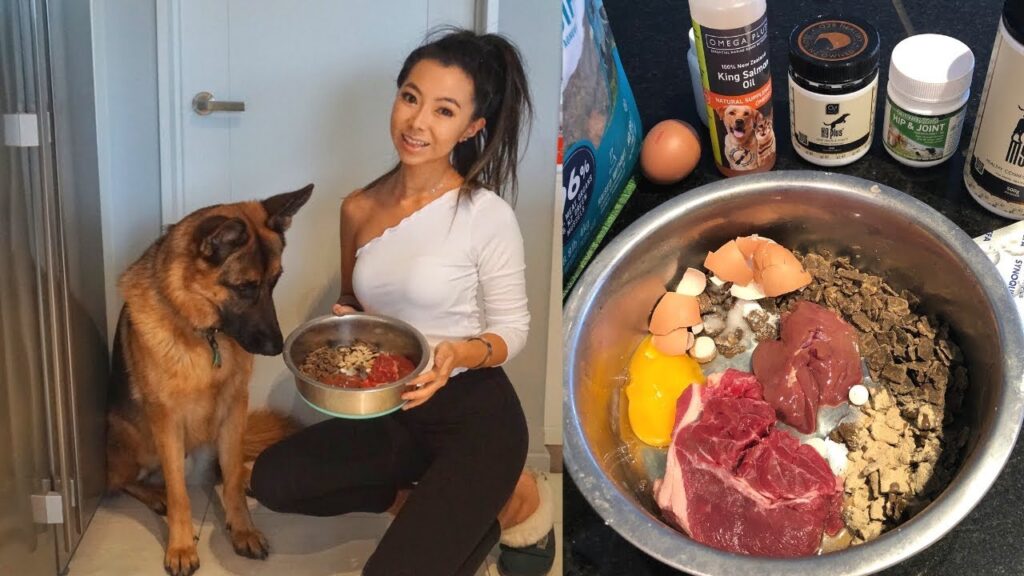A raw food diet for German Shepherds involves feeding them uncooked meat, bones, fruits, and vegetables. This diet aims to mimic their ancestral eating habits.
German Shepherds thrive on high-quality nutrition, making the raw food diet an appealing choice for many owners. This approach prioritizes whole, unprocessed foods that can enhance health and energy levels. Advocates believe that raw diets can improve coat quality, digestion, and overall vitality.
Careful planning is essential to ensure that dogs receive balanced nutrition. It’s important to consider factors such as the right protein sources and the appropriate ratio of meat to vegetables. Always consult a veterinarian before making significant dietary changes, as individual needs may vary among dogs.
Introduction To Raw Food Diets
A Raw Food Diet for German Shepherds focuses on feeding them raw meats, bones, fruits, and vegetables. This diet mimics what dogs ate in the wild. Many owners choose this for its natural benefits. Understanding this diet is crucial for your dog's health.
Benefits For German Shepherds
Feeding your German Shepherd a raw food diet offers several advantages:
- Improved Digestion: Raw food is easier to digest.
- Better Coat: Dogs often have shinier, healthier fur.
- Increased Energy: Many owners notice higher energy levels.
- Healthier Teeth: Chewing raw bones helps clean teeth.
- Weight Management: Raw diets can help maintain ideal weight.
Common Misconceptions
Many people misunderstand raw food diets. Here are some common myths:
| Myth | Fact |
|---|---|
| Raw diets are dangerous. | With proper handling, raw diets can be safe. |
| Dogs need grains. | Dogs do not require grains in their diet. |
| All raw meat is the same. | Quality of meat matters for nutrition. |
| Raw diets are expensive. | Costs can be managed with planning. |
Understanding these facts helps in making informed choices. Your German Shepherd deserves the best nutrition.

Customize Homemade Dog Food
Key Components Of A Balanced Raw Diet
A balanced raw diet for German Shepherds focuses on essential nutrients. Each component plays a vital role in their health. Understanding these components helps you provide the best nutrition.
Proteins: Types And Sources
Protein is crucial for muscle growth and repair. It supports a strong immune system.
- Animal Proteins: Chicken, beef, lamb, and fish.
- Organ Meats: Liver, kidney, and heart.
- Eggs: Whole eggs are excellent protein sources.
Choose high-quality proteins. Vary the sources to ensure a balanced diet.
Fats: Essential Fatty Acids
Fats provide energy and support skin and coat health. They help with nutrient absorption.
- Omega-3 Fatty Acids: Found in fish oil and flaxseed oil.
- Omega-6 Fatty Acids: Present in chicken fat and vegetable oils.
Include both types of fats in your dog's diet. This promotes overall health.
Carbohydrates: To Include Or Not?
Carbohydrates can be beneficial but should be limited. Dogs are primarily carnivores.
Consider these options:
- Fruits: Apples, blueberries, and bananas.
- Vegetables: Carrots, spinach, and sweet potatoes.
Focus on low-starch vegetables. Avoid grains and fillers for better digestion.
Vitamins And Minerals: Ensuring Adequacy
Vitamins and minerals are essential for overall health. They support various bodily functions.
| Vitamin/Mineral | Sources |
|---|---|
| Vitamin A | Liver and carrots |
| Calcium | Bone meal and leafy greens |
| Vitamin E | Fish oil and nuts |
| Magnesium | Spinach and pumpkin seeds |
Consult a vet for specific needs. Supplements may be necessary.
Transitioning Your German Shepherd To Raw Food
Switching your German Shepherd to a raw food diet is a rewarding process. This diet can improve their health and energy levels. A gradual transition helps prevent digestive issues. Follow this guide to make the switch smooth and effective.
Step-by-step Guide
Here is a simple step-by-step guide to transition your dog:
- Start Slow: Introduce raw food gradually. Begin with 10% raw food mixed with 90% current food.
- Observe Reactions: Watch for any signs of allergies or upset stomach.
- Increase Raw Food: After a week, increase raw to 20%. Monitor your dog's response.
- Continue Gradually: Keep increasing raw food by 10% each week.
- Complete Switch: Aim for a full transition in 4 to 6 weeks.
Use the following table to track your dog's transition progress:
| Week | Raw Food Percentage | Notes |
|---|---|---|
| 1 | 10% | Monitor for allergies. |
| 2 | 20% | Check digestion. |
| 3 | 30% | Watch for energy changes. |
| 4 | 40% | Assess overall health. |
| 5 | 50% | Continue monitoring. |
| 6 | 100% | Full raw diet. |
Monitoring Your Dog's Health During Transition
Keep a close eye on your German Shepherd's health. Look for these signs:
- Energy Levels: Increased energy indicates a good diet.
- Coat Condition: A shiny coat shows proper nutrition.
- Stool Quality: Firm stools suggest healthy digestion.
- Weight Changes: Maintain a healthy weight throughout.
Take advice from Pet Expert Dr Marty
ESA Pet is an online service that helps you get a legitimate ESA letter
Pet vitamin supplements and grooming products
If you notice any issues, consult your veterinarian. Adjust the transition plan if necessary. This ensures your dog stays healthy and happy.

Customize Homemade Dog Food
Raw Food Recipes And Meal Planning
Planning a raw food diet for your German Shepherd requires creativity and balance. Homemade meals can provide essential nutrients. Let’s explore simple recipes and how to create balanced meal plans.
Simple Starter Recipes
Here are some easy raw food recipes. These recipes use basic ingredients and are nutritious.
- Chicken and Veggie Mix
- 1 cup raw chicken (boneless)
- ½ cup carrots (chopped)
- ½ cup spinach (chopped)
- 1 tablespoon fish oil
Combine all ingredients. Serve fresh.
- Beef and Rice Bowl
- 1 cup raw ground beef
- ½ cup cooked brown rice
- ¼ cup peas
- 1 tablespoon olive oil
Mix all ingredients. Serve warm.
- Turkey Delight
- 1 cup raw ground turkey
- ½ cup sweet potatoes (mashed)
- ¼ cup green beans
- 1 tablespoon flaxseed oil
Stir together. Serve fresh.
Creating A Balanced Meal Plan
A balanced meal plan is vital for your dog's health. Use the following guidelines:
| Food Group | Recommended Percentage |
|---|---|
| Protein Sources | 40-50% |
| Vegetables | 30-40% |
| Fruits | 10-20% |
| Healthy Fats | 10% |
Use these steps to plan meals:
- Choose protein sources like chicken, beef, or turkey.
- Select vegetables such as carrots, spinach, or peas.
- Add fruits like apples or blueberries for vitamins.
- Incorporate healthy fats like fish oil or flaxseed oil.
Adjust the meal plan based on your dog's needs. Monitor your dog's weight and health regularly. Consult your vet for personalized advice.
Addressing Common Health Concerns
Many German Shepherd owners worry about health issues. A raw food diet can help address these concerns. This section explores common health problems and solutions through diet.
Allergies And Sensitivities
German Shepherds often suffer from allergies. Common allergens include:
- Grains
- Processed foods
- Certain proteins
A raw food diet can minimize these issues. Fresh ingredients may reduce allergic reactions.
Consider these proteins:
- Chicken
- Beef
- Fish
Monitor your dog for any reactions. Always consult a vet for allergies.
Maintaining Dental Health
Dental health is crucial for German Shepherds. A raw food diet can improve oral hygiene. Raw bones help keep teeth clean.
Benefits of raw bones:
- Reduces plaque buildup
- Strengthens jaw muscles
- Freshens breath
Choose bones that are safe and appropriate. Avoid cooked bones, as they can splinter.
Weight Management
Obesity can lead to many health problems. A raw food diet supports healthy weight. It provides balanced nutrition without fillers.
Consider these tips for weight management:
- Control portion sizes.
- Include lean proteins.
- Limit treats and snacks.
Regular exercise is also essential. Keep your dog active to maintain a healthy weight.
Safety Measures And Best Practices
Feeding your German Shepherd a raw food diet can be rewarding. Safety is crucial to avoid health risks for your dog and family. Follow these guidelines to ensure safe handling and storage of raw food.
Handling Raw Meat
Proper handling of raw meat is vital. Follow these steps:
- Wash hands before and after handling raw meat.
- Use separate cutting boards for meat and vegetables.
- Keep raw meat away from ready-to-eat foods.
- Use gloves to reduce direct contact.
- Always supervise your dog during feeding.
Storing Raw Food
Storage is essential for maintaining food safety. Use these tips:
| Storage Method | Description |
|---|---|
| Refrigeration | Store raw food in a sealed container. Keep below 40°F (4°C). |
| Freezing | Freeze raw meat to keep it fresh. Use within 6 months. |
| Thawing | Thaw meat in the refrigerator. Never leave at room temperature. |
Preventing Contamination
Preventing contamination is key. Follow these practices:
- Clean surfaces and utensils regularly.
- Dispose of any unused raw food promptly.
- Avoid cross-contamination with other foods.
- Monitor your dog for signs of illness.
- Consult your vet if any issues arise.
By following these safety measures, your German Shepherd will enjoy a healthy raw food diet.
Cost Analysis And Budgeting
Understanding the costs of a raw food diet for your German Shepherd is crucial. It helps you make informed decisions about your dog's nutrition. A raw diet can be more affordable or expensive than commercial diets. Here, we analyze costs and provide budgeting tips.
Comparing Costs: Raw Vs. Commercial Diets
Costs can vary widely between raw and commercial diets. Below is a breakdown of typical expenses:
| Diet Type | Average Monthly Cost | Key Ingredients |
|---|---|---|
| Raw Diet | $100 – $300 | Meat, bones, organs, fruits, vegetables |
| Commercial Diet | $50 – $200 | Kibble, canned food, treats |
Raw diets may seem costly. They can also provide better nutrition. High-quality ingredients lead to healthier dogs. Consider your dog's specific needs and activity levels.
Tips For Budget-friendly Raw Feeding
Raw feeding doesn't have to break the bank. Here are some smart strategies:
- Buy in Bulk: Purchase meats and ingredients in larger quantities. This often reduces the price per unit.
- Seasonal Ingredients: Use fruits and vegetables that are in season. They're often cheaper and fresher.
- Local Sources: Check local farms and butcher shops. They may offer discounts for raw feeding.
- DIY Treats: Make your own dog treats. Simple recipes can use leftover ingredients.
- Plan Meals: Create a meal plan for your dog. This helps avoid impulse buys and waste.
Budgeting for a raw diet requires careful planning. With these tips, you can provide excellent nutrition without overspending.
Real-life Success Stories
Many German Shepherd owners have seen amazing results on a raw food diet. These real-life success stories highlight the benefits of this diet. Dogs experience improved health, energy, and happiness. Let's explore some inspiring case studies and insights from veterinarians.
Case Studies
Here are some remarkable case studies from German Shepherd owners:
- Max's Transformation:
Max, a 6-year-old German Shepherd, struggled with skin allergies. His owner switched him to a raw food diet. Within weeks, his allergies improved significantly. His coat became shiny and healthy.
- Bella's Weight Loss:
Bella was overweight and lethargic. After starting a raw diet, she lost 10 pounds. Bella now enjoys playing fetch and runs around happily.
- Rocky's Joint Health:
Rocky, an older German Shepherd, had joint issues. His owner included raw bones in his diet. Rocky's mobility improved, and he became more active.
Veterinarian Insights
Veterinarians have shared their thoughts on the raw food diet for German Shepherds.
| Veterinarian | Insight |
|---|---|
| Dr. Smith | Raw diets can boost energy levels in active dogs. |
| Dr. Johnson | Fresh ingredients may improve coat health. |
| Dr. Lee | Properly balanced raw diets support joint health. |
These insights emphasize the positive effects of a raw food diet. Many veterinarians support this approach for healthy, active dogs.

Customize Homemade Dog Food
Frequently Asked Questions On Raw Food Diet for German Shepherds
What Is A Raw Food Diet For Dogs?
A raw food diet for dogs consists of unprocessed, uncooked ingredients. It typically includes raw meat, bones, fruits, and vegetables. Advocates believe this natural diet mimics what dogs would eat in the wild. It can promote better digestion, healthier skin, and increased energy levels.
Is A Raw Food Diet Safe For German Shepherds?
Yes, a raw food diet can be safe for German Shepherds when done correctly. It’s essential to balance nutrients and ensure food safety. Consult your veterinarian before starting this diet to avoid health risks. Proper preparation and sourcing are crucial to prevent bacterial contamination and nutritional deficiencies.
What Are The Benefits Of Raw Feeding?
Raw feeding offers numerous benefits for dogs. It can improve coat quality, boost energy levels, and enhance dental health. Dogs may also experience better digestion and weight management. Additionally, raw diets can lead to fewer allergies and a more vibrant overall health profile.
How To Transition My Dog To A Raw Food Diet?
Transition your dog gradually to a raw food diet. Start by mixing raw food with their current diet. Over a week, slowly increase the raw portion while decreasing the old food. Monitor your dog for any digestive issues during this process to ensure a smooth transition.
Customize Homemade Dog Food
Conclusion
A raw food diet can greatly benefit German Shepherds. It promotes better digestion, healthier coats, and increased energy levels. Always consult with a veterinarian before making dietary changes. Tailoring meals to your dog's specific needs will ensure optimal health. Embrace this natural approach for a happier, healthier companion.














